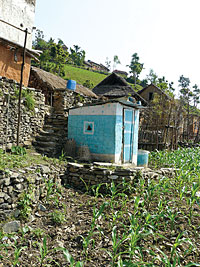 RABI THAPA |
Last week's report from the World Health Organization was sure to embarrass the sloganeers of India Shining. Of a total 1.2 billion people who practice open defaecation, a staggering 665 million live in India. But before you start to snigger, take a look at your own backyard. Nepal features prominently in the report, with 14 million of its citizens going for nature's calls in, well, nature.
Fourteen million makes for half the population without access to proper toilets. But the significance of this statistic is much less the shame of it than what it means for the health of the population, particularly in the countryside. Over 15,000 children under five die of diarrhea every year in Nepal, and the recent epidemic in western Nepal claimed hundreds of lives. What does this say about the much-vaunted efforts of the government and donors to meet the Millennium Development Goal for sanitation?
Suman Prasad Sharma, joint secretary at the Water and Sanitation Division of the Ministry of Physical Planning and Works, says the government has been providing subsidies of upto Rs 2,000 to build toilets. But he admits that subsidies are of little use without effecting a change in attitudes towards health and hygiene. To this end, the government has introduced school led total sanitation (SLTS) and community led total sanitation (CLTS) programs across the country. These programs seek to spread awareness of hygienic practices through communities and schoolchildren in particular, seen as potent agents of social change.
Are these programs workings? The government claims about 48 per cent of the population enjoys sanitation facilities and 78 per cent has access to safe drinking water. But districts like Rukum and Jajarkot are way behind the national average: only 23 per cent have access to toilets and 46 per cent have a supply of clean drinking water.
Says Bishwa Raj Khanal, senior epidemiologist with the Department of Health Services, "Places in the mid west like Jajarkot and Rukum do have sanitation programs in place, but very limited health services and workers. The communities have little access to clean drinking water and are generally unaware of the importance of good sanitation practices, even basic things like washing hands before eating and after going to the toilet."
In the areas hit by the epidemic, according to Khanal, the difficult terrain and the lack of coordination on the part of the district disaster relief committee compounded the situation. The rest is a sad history.
"Water and sanitation are like stones and soil"
There's a plethora of initiatives to provide sanitation facilities in rural and urban areas in Nepal. For the large part these are coupled with water supply projects. As Shankha Buddha Lama of the Shanti Jan Adarsha Youth Club puts it, "Water supply and sanitation are like stones and soil - you can't have one without the other."
In Kavrepalanchok, Shankha Buddha's organisation is the chief support organisation for the Rural Water Supply and Sanitation Fund Development Board, an semi-autonomous institution funded by the World Bank and DfID. Over the last decade, Shankha Buddha has become something of a celebrity in Kavre. He has made it his mission to bring water and sanitation to his district by reconnoitering potential project sites and selecting them on the basis of demand and willingness to adopt a community participation model that includes women.
Kavre has enjoyed success, with several villages declaring themselves 'ODF' - open defaecation free. Toilet use has been joined to mini-biogas plants in some sites, whereby human and animal waste is converted into gas, the residue is used as fertiliser, and firewood use is reduced. Though villagers initially demand water, they are soon convinced, sometimes by visiting other sites, of the advantages to their health and environment of using toilets.
At the closing event of National Sanitation Week in July in district headquarters Dhulikhel, schoolchildren enlivened the speeches with a carefully rehearsed 'sanitation song'. Shankha Buddha himself took the podium to suggest that parents desist from marrying daughters into houses without toilets. A government official was a little more circumspect, noting that Nepal was some way away from meeting its targets. "But Kavre could be a model," he said. "Why not make the entire district ODF by 2012-13? Ghar ghar ma sauchalaya, Kavre jilla ko parichaya." A toilet in every house, the introduction to Kavre.


